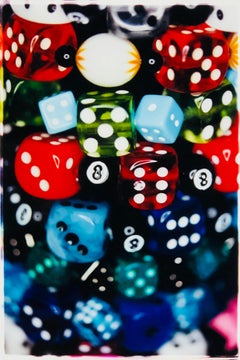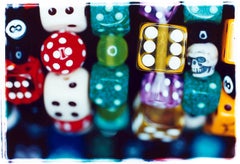Dice Richard Heeps
2010s Pop Art Color Photography
Photographic Paper, C Print, Color, Silver Gelatin
2010s Pop Art Color Photography
Photographic Paper, C Print, Color, Silver Gelatin
2010s Pop Art Color Photography
Photographic Paper, C Print, Color, Silver Gelatin
2010s Pop Art Color Photography
Photographic Paper, C Print, Color, Silver Gelatin
Recent Sales
2010s Pop Art Color Photography
Photographic Paper, C Print, Color, Silver Gelatin
People Also Browsed
21st Century and Contemporary Conceptual Color Photography
Archival Ink, Archival Paper, Photographic Paper, Archival Pigment, Giclée
1920s Modern Photography
Silver Gelatin
Antique 19th Century French Shelves
Metal
Late 20th Century Neo-Expressionist Figurative Paintings
Mixed Media
2010s Realist Figurative Paintings
Cotton Canvas, Acrylic
21st Century and Contemporary Contemporary Color Photography
Plexiglass, C Print
1970s Pop Art Prints and Multiples
Paper
2010s Polish Organic Modern Wall Mirrors
Steel
2010s Abstract Geometric Abstract Paintings
Canvas, Acrylic
2010s Contemporary Figurative Paintings
Canvas, Oil
2010s Abstract Abstract Paintings
Canvas, Ink, Acrylic
21st Century and Contemporary Contemporary Figurative Paintings
Canvas, Oil
2010s Contemporary Figurative Paintings
Canvas, Acrylic
21st Century and Contemporary Abstract Figurative Paintings
Canvas, Oil
Vintage 1980s European Chandeliers and Pendants
Blown Glass
2010s Pop Art Figurative Paintings
Resin, Oil, Acrylic, Wood Panel
Richard Heeps for sale on 1stDibs
A Close Look at Pop Art Art
Perhaps one of the most influential contemporary art movements, Pop art emerged in the 1950s. In stark contrast to traditional artistic practice, its practitioners drew on imagery from popular culture — comic books, advertising, product packaging and other commercial media — to create original Pop art paintings, prints and sculptures that celebrated ordinary life in the most literal way.
ORIGINS OF POP ART
- Started in Britain in the 1950s, flourished in 1960s-era America
- “This is Tomorrow,” at London's Whitechapel Gallery in 1956, was reportedly the first Pop art exhibition
- A reaction to postwar mass consumerism
- Transitioning away from Abstract Expressionism
- Informed by neo-Dada and artists such as Jasper Johns and Robert Rauschenberg; influenced postmodernism and Photorealism
CHARACTERISTICS OF POP ART
- Bold imagery
- Bright, vivid colors
- Straightforward concepts
- Engagement with popular culture
- Incorporation of everyday objects from advertisements, cartoons, comic books and other popular mass media
POP ARTISTS TO KNOW
- Richard Hamilton
- Andy Warhol
- Marta Minujín
- Claes Oldenburg
- Eduardo Paolozzi
- Rosalyn Drexler
- James Rosenquist
- Peter Blake
- Roy Lichtenstein
ORIGINAL POP ART ON 1STDIBS
The Pop art movement started in the United Kingdom as a reaction, both positive and critical, to the period’s consumerism. Its goal was to put popular culture on the same level as so-called high culture.
Richard Hamilton’s 1956 collage Just what is it that makes today’s homes so different, so appealing? is widely believed to have kickstarted this unconventional new style.
Pop art works are distinguished by their bold imagery, bright colors and seemingly commonplace subject matter. Practitioners sought to challenge the status quo, breaking with the perceived elitism of the previously dominant Abstract Expressionism and making statements about current events. Other key characteristics of Pop art include appropriation of imagery and techniques from popular and commercial culture; use of different media and formats; repetition in imagery and iconography; incorporation of mundane objects from advertisements, cartoons and other popular media; hard edges; and ironic and witty treatment of subject matter.
Although British artists launched the movement, they were soon overshadowed by their American counterparts. Pop art is perhaps most closely identified with American Pop artist Andy Warhol, whose clever appropriation of motifs and images helped to transform the artistic style into a lifestyle. Most of the best-known American artists associated with Pop art started in commercial art (Warhol made whimsical drawings as a hobby during his early years as a commercial illustrator), a background that helped them in merging high and popular culture.
Roy Lichtenstein was another prominent Pop artist that was active in the United States. Much like Warhol, Lichtenstein drew his subjects from print media, particularly comic strips, producing paintings and sculptures characterized by primary colors, bold outlines and halftone dots, elements appropriated from commercial printing. Recontextualizing a lowbrow image by importing it into a fine-art context was a trademark of his style. Neo-Pop artists like Jeff Koons and Takashi Murakami further blurred the line between art and popular culture.
Pop art rose to prominence largely through the work of a handful of men creating works that were unemotional and distanced — in other words, stereotypically masculine. However, there were many important female Pop artists, such as Rosalyn Drexler, whose significant contributions to the movement are recognized today. Best known for her work as a playwright and novelist, Drexler also created paintings and collages embodying Pop art themes and stylistic features.
Read more about the history of Pop art and the style’s famous artists, and browse the collection of original Pop art paintings, prints, photography and other works for sale on 1stDibs.
Finding the Right Color-photography for You
Color photography evokes emotion that can bring a viewer into the scene. It can transport one to faraway places or back into the past.
The first color photograph, taken in 1861, was more of an exercise in science than art. Photographer Thomas Sutton and physicist James Clerk Maxwell used three separate exposures of a tartan ribbon — filtered through red, green and blue — and composited them into a single image, resulting in the first multicolor representation of an object.
Before this innovation, photographs were often tinted by hand. By the 1890s, color photography processes were introduced based on that 1860s experiment. In the early 20th century, autochromes brought color photography to a commercial audience.
Now color photography is widely available, with these historic photographs documenting moments and scenes that are still vivid generations later. Photographers in the 20th and 21st centuries have offered new perspectives in the evolving field of modern color photography with gripping portraiture, snow-capped landscapes, stunning architecture and lots more.
In the voluminous collection of photography on 1stDibs, find vibrant full-color images by Slim Aarons, Helen Levitt, Gordon Parks, Stefanie Schneider, Steve McCurry and other artists. Bring visual interest to any corner of your home with color photography — introduce a salon-style gallery hang or another arrangement that best fits your space.




